Boeing's Carson to be replaced by Albaugh
My comment:
see, the 787 is still on track to produce a profit, the wing fix is all figured out and it's really, really going to fly this time in December, everything is completely according to control and going according to plan. Oh yeah, and we're firing the guy in charge of all commercial jetliners since he's done such a great job...... Why doesn't the Times mention that the Dash 80 went from "let's build this thing" to first flight (including a collapsed landing gear) in just 2 years, less time that it's taken Boeing to just FIX the plane they've already rolled out?
Monday, August 31, 2009
Friday, August 28, 2009
Boeing Dash-80 (707) Prototype from spec to flying in just 2 years!
The entire Boeing 707 (Dash 80) prototype went from project launch to first flight in less time than the delay it took in fixing the "finished" 787 after its rollout.
Boeing still sure delayed 787 will be profitable
Even as executives announced a massive $2.5 billion write-off associated with the first-flight delays that now stretch to 28 months, they expressed confidence in its latest revised schedule.
By Dominic Gates
Boeing said Thursday it will still make a profit on its 787 Dreamliner program, now the most delayed — and, according to analysts, the most expensive — jet in the company's history.
------------------------------------------------------------------------------
Anybody remember the good old days?
The "Dash 80" (prototype of the 707, which was completely different from any previous Boeing airplane) took less than two years from project launch in 1952 to rollout on May 14, 1954 and first flight on July 15,1954.
The ENTIRE FREAKING PROJECT took place in less time than the delay between the "rollout" and the projected first flight of the 787. Every other Boeing airliner flew within 4 months of rollout, and the original promise first flight date was based on these schedules. Something is very, very amiss.
Other airplanes put into production before prototypes proved the design had problems too. The dart-wing YF-102 could not even break the sound barrier until body was completely reshaped with area ruling. 21 F3H Demons (McDonnell, one of the ancestors of McDac/Boeing) were built and delivered for ground training because the J40 engine they were designed for were declared unsafe to fly.
Boeing still sure delayed 787 will be profitable
Even as executives announced a massive $2.5 billion write-off associated with the first-flight delays that now stretch to 28 months, they expressed confidence in its latest revised schedule.
By Dominic Gates
Boeing said Thursday it will still make a profit on its 787 Dreamliner program, now the most delayed — and, according to analysts, the most expensive — jet in the company's history.
------------------------------------------------------------------------------
Anybody remember the good old days?
The "Dash 80" (prototype of the 707, which was completely different from any previous Boeing airplane) took less than two years from project launch in 1952 to rollout on May 14, 1954 and first flight on July 15,1954.
The ENTIRE FREAKING PROJECT took place in less time than the delay between the "rollout" and the projected first flight of the 787. Every other Boeing airliner flew within 4 months of rollout, and the original promise first flight date was based on these schedules. Something is very, very amiss.
Other airplanes put into production before prototypes proved the design had problems too. The dart-wing YF-102 could not even break the sound barrier until body was completely reshaped with area ruling. 21 F3H Demons (McDonnell, one of the ancestors of McDac/Boeing) were built and delivered for ground training because the J40 engine they were designed for were declared unsafe to fly.
Thursday, August 27, 2009
The 787 Dreamliner Will Fly Before Years End. Right.
Boeing sets schedule for 787 1st flight Boeing Co. said Thursday its long-delayed 787 jetliner will be ready for its maiden test flight by year's end and its first delivery in the fourth quarter next year.
By DANIEL LOVERING
AP Manufacturing Writer
Boeing Co. said Thursday its long-delayed 787 jetliner will be ready for its maiden test flight by year's end and its first delivery in the fourth quarter next year.
---------------------
Reminds me of the rolling 3 month deadline we did in 80s software heyday. We'll ship 3 months from now, even if that was what we said a year ago. Vaporware they used to call it. They haven't even confirmed how they're going to fix the wing, let alone start tearing the wing down to put the fix in, and it's going to fly in 3 months??? You what they say in software, the last 10% takes 50% of the time.
Here's Boeing's record on time between roll out and first flight. It's usually between 1 and 4 months, but the 787 is way, way off by over 2 years. Is it really true that the first roll out was fake, rolling out an unfinished shell of an airplane just for show? The new delay in date they're quoting now is the same as back in 2007, 3 or 4 months away, except they didn't promise they would have to fix the wings back then.
Rollout First Flight Days Months
Boeing B-17 7/1/1935 7/28/1935 27 1
Boeing B-52 #N/A 4/15/1952 #N/A
Boeing 747 9/30/1968 2/9/1969 132 4
Boeing 707 5/14/1954 7/15/1954 62 2
Boeing 727 11/27/1962 2/9/1963 74 2
Boeing 737 1/17/1967 4/9/1967 82 3
Boeing 757 1/13/1982 2/19/1982 37 1
Boeing 767 8/4/1981 9/26/1981 53 2
Boeing 777 4/9/1994 6/12/1994 64 2
Initial schedule
Boeing 787 7/8/2007 8/27/2007 50 2
August 2009 schedule
Boeing 787 7/8/2007 12/20/200 896 30
http://en.wikipedia.org/wiki/Cost_overrun
Cost overrun is defined as excess of actual cost over budget. Cost overrun is also sometimes called "cost escalation," "cost increase," or "budget overrun." However, cost escalation and increases do not necessarily result in cost overruns if cost escalation is included in the budget.
Cost overrun is common in infrastructure, building, and technology projects. One of the most comprehensive studies [1] of cost overrun that exists found that 9 out of 10 projects had overrun, overruns of 50 to 100 percent were common, overrun was found in each of 20 nations and five continents covered by the study, and overrun had been constant for the 70 years for which data were available. For IT projects, an industry study by the Standish Group (2004) found that average cost overrun was 43 percent, 71 percent of projects were over budget, over time, and under scope, and total waste was estimated at US$55 billion per year in the US alone.
Spectacular examples of cost overrun are the Sydney Opera House with 1,400 percent, and the Concorde supersonic aeroplane with 1,100 percent. The cost overrun of Boston's Big Dig was 275 percent, or US$11 billion. The cost overrun for the Channel tunnel between the UK and France was 80 percent for construction costs and 140 percent for financing costs.
Three types of explanation of cost overrun exist: technical, psychological, and political-economic. Technical explanations account for cost overrun in terms of imperfect forecasting techniques, inadequate data, etc. Psychological explanations account for overrun in terms of optimism bias with forecasters. Finally, political-economic explanations see overrun as the result of strategic misrepresentation of scope and/or budgets.
Tuesday, August 25, 2009
Putting the PDP-11 in perspective, and the 64k barrier
I just updated the Wikipedia PDP-11 article to reflect what really happened to it, and why it's really important to computers today. I worked summers in the late 70s at Hewlett Packard and in the early 1980s at DEC and Data General as the PDP-11 died off. The HP computer software was much clunkier than DEC, though the HP 3000 was rock solid in terms of staying up in operation. HPs were in industry, but there were none in computer science labs. One day I thought, HP would build real computers - and now they're the biggest computer company, having bought out the remains of DEC after it (and every other New England based computing company) collapsed after the 1980s.
A minicomputer was originally a computer the size of a refrigerator as opposed to something that took up most of a room if not a building. It used to be something that you could attach up to 64k bytes of memory which cost an awful lot, and was made of boards that plugged into a box with a front panel with blinking lights and switches. The PDP-8 was based on having on accumulator register, and a guy who suggested doing a better one was turned down, and he moved down I495 to found Data General and the Nova. Hewlett Packard bought a company that built a computer with an AX and BX registers which became the 2100/HP1000, and Intel down the street from HP would start with 1 accumulator on the 8080, then put AX, BX, CX and DX registers in the Pentium to this very day. The PDP-11 introduced the idea of 8 general registers, r1 through r8, using one as a stack register, which is much of the reason that programmers to this day hate the Intel architecture with a passion. On the 64bit, AMD's extension to x86 has registers r9 to r15, PDP-11 style.
The PDP-11 was the 2nd platform for Unix after the PDP-7, but when it was ported to the PDP-11/20, it was the first to be offically called Unix, and PDP-11 features inspired the infamous byte features of the C language which was used to rewrite Unix in the high level language, which was pretty unusual but not a first. The big thing that killed it was the infamous 64k barrier which is what happens when it's cheap enough to add megabyte(s) to a processor that doesn't have registers with enough bits to count beyond 64k. There were workarounds (using bank switching, used to extend the PDP-8 beyond 12 bits / 4K, and the IBM PC beyond 20 bits / 1M) but they were awkward and not a real alternative to flat addressing. The HP3000 segmented architecture got around the 64k barrier because it was already based on segments. As long as no single code routine was over 64k and no chunk of data was over 64k, you could have lots of 64k code and data segments, and that was fine for COBOL business applications. HP eventually migrated the whole thing to a RISC processor, it wasn't withdrawn until after VAX died.
The VAX-11 extended PDP-11. It partially solved the problem with 32 bit addressing 2G or 4G. We'll never use 2G I thought! Now it takes 64 bit Windows to properly run more than the 2G of RAM you can buy at Target today (late Pentiums also have tricks to get up to 64G of RAM with 32 bit addresses). But the VAX was a monster system, not something that fit in one rack or a desktop. The Motorola 68000 was based on PDP-11 ideas, and was the favorite for desk sized systems with megabytes of memory. It had 32 bit wide registers, but only later could address a full 32 bits of memory. Intel's 808x started with the 8 bit 8080 which had but one accumulator, like the old PDP-8. It got beyond 64k by merely tacking on a 4 bit "segment" address which enabled you to juggle 64k byte segments at a time. It threw a monkey wrench into programming, but as long as hundreds of thousands of these things could run the software, you could afford to pay a few clever guys to get around a chip that was awful to program. (One guy Bill Gates would be paid a LOT) That hack was just good enough for a PC where it was costly to put in 1M of memory. It wasn't until the 386 that Intel got full 32 bit addressing, (the 286 was largely ignored because it couldn't quite hack the full 32 bit trick) but that was enough. The 68000 was popular in the Mac until replaced by RISC, and now it's x86.
Today's multi-core Pentium 64 is still basically a x86 that chugs along as an 8080 with hacks upon more hacks, managing to fend off every more advanced architecture up to Itanium through sheer economies of scale and incremental refinement. The Itanium was a megaproject to replace high-end x86 and other RISC with a super-parallel 64 bit chip. It was assumed that it would be so fast, you could run old x86 stuff by running an emulator. But it turned out that the hardware couldn't compete with the mass numbers of x86 chips that kept advancing in speed, and most commercial apps couldn't use the fancy compilers that nobody seemed to be able to write that would make programs run much faster if you could execute 6 instructions at once. AMD, who made a living copying the x86 thought that was silly, and went ahead and came up with their own hack to extend x86 to 64 bits. It sold so well that Intel had to copy AMD's version, so the x86 today dominates 64 bit chips, though the Itanium has eeked out niche at the very high end (There's a youtube video of how an Itanium smokes AMD for a mandelbrodt set 12 to 1, but then how many of us do that vs web surfing?)
The other problem was when Bill Gates changed the model for operating system by writing one for Intel's 808x which was originally designed to be used for any BUT a general computer. Now most computers run either Windows, a descendent of CP/M which was a port of the PDP-11 operating system, or Unix, which was originally written for the PDP-11 in its 2nd version.
-------------------------------------
The PDP-11 was a series of 16-bit minicomputers sold by Digital Equipment Corp. from 1970[1][2] into the 1990s.[2] Though not explicitly conceived as successor to DEC's PDP-8 computer in the PDP series of computers (both product lines lived in parallel for more than 10 years), the PDP-11 replaced the PDP-8 in many real-time applications. It had several uniquely innovative features, and was easier to program than its predecessors with its use of general registers. The 64k barrier became a significant limitation as megabytes of installed memory became common. It was replaced in the mid-range minicomputer niche by the VAX-11 32-bit extension of the PDP-11.
Smaller personal computers such as the IBM PC, and workstations and servers by vendors such as Sun Microsystems became popular based on standard microprocessors such as the Intel x86 and Motorola 68000, As a PDP-11 based personal computer offering failed in the marketplace, these computers using standard operating systems such as MS-DOS and Unix would eventually evolve up to full 32 bit memory addressing, and replace most proprietary minicomputer and midrange computers including the VAX-11.
Design features of the PDP-11 and its operating systems influenced the design of microprocessors such as the 68000, CP/M and DOS which are still common in current computers and operating systems. The first officially named version of Unix ran on the PDP-11/20 in 1970. The C programming language was written to take advantage of PDP-11 programming features such as byte addressing to rewrite Unix in a high level language.
A minicomputer was originally a computer the size of a refrigerator as opposed to something that took up most of a room if not a building. It used to be something that you could attach up to 64k bytes of memory which cost an awful lot, and was made of boards that plugged into a box with a front panel with blinking lights and switches. The PDP-8 was based on having on accumulator register, and a guy who suggested doing a better one was turned down, and he moved down I495 to found Data General and the Nova. Hewlett Packard bought a company that built a computer with an AX and BX registers which became the 2100/HP1000, and Intel down the street from HP would start with 1 accumulator on the 8080, then put AX, BX, CX and DX registers in the Pentium to this very day. The PDP-11 introduced the idea of 8 general registers, r1 through r8, using one as a stack register, which is much of the reason that programmers to this day hate the Intel architecture with a passion. On the 64bit, AMD's extension to x86 has registers r9 to r15, PDP-11 style.
The PDP-11 was the 2nd platform for Unix after the PDP-7, but when it was ported to the PDP-11/20, it was the first to be offically called Unix, and PDP-11 features inspired the infamous byte features of the C language which was used to rewrite Unix in the high level language, which was pretty unusual but not a first. The big thing that killed it was the infamous 64k barrier which is what happens when it's cheap enough to add megabyte(s) to a processor that doesn't have registers with enough bits to count beyond 64k. There were workarounds (using bank switching, used to extend the PDP-8 beyond 12 bits / 4K, and the IBM PC beyond 20 bits / 1M) but they were awkward and not a real alternative to flat addressing. The HP3000 segmented architecture got around the 64k barrier because it was already based on segments. As long as no single code routine was over 64k and no chunk of data was over 64k, you could have lots of 64k code and data segments, and that was fine for COBOL business applications. HP eventually migrated the whole thing to a RISC processor, it wasn't withdrawn until after VAX died.
The VAX-11 extended PDP-11. It partially solved the problem with 32 bit addressing 2G or 4G. We'll never use 2G I thought! Now it takes 64 bit Windows to properly run more than the 2G of RAM you can buy at Target today (late Pentiums also have tricks to get up to 64G of RAM with 32 bit addresses). But the VAX was a monster system, not something that fit in one rack or a desktop. The Motorola 68000 was based on PDP-11 ideas, and was the favorite for desk sized systems with megabytes of memory. It had 32 bit wide registers, but only later could address a full 32 bits of memory. Intel's 808x started with the 8 bit 8080 which had but one accumulator, like the old PDP-8. It got beyond 64k by merely tacking on a 4 bit "segment" address which enabled you to juggle 64k byte segments at a time. It threw a monkey wrench into programming, but as long as hundreds of thousands of these things could run the software, you could afford to pay a few clever guys to get around a chip that was awful to program. (One guy Bill Gates would be paid a LOT) That hack was just good enough for a PC where it was costly to put in 1M of memory. It wasn't until the 386 that Intel got full 32 bit addressing, (the 286 was largely ignored because it couldn't quite hack the full 32 bit trick) but that was enough. The 68000 was popular in the Mac until replaced by RISC, and now it's x86.
Today's multi-core Pentium 64 is still basically a x86 that chugs along as an 8080 with hacks upon more hacks, managing to fend off every more advanced architecture up to Itanium through sheer economies of scale and incremental refinement. The Itanium was a megaproject to replace high-end x86 and other RISC with a super-parallel 64 bit chip. It was assumed that it would be so fast, you could run old x86 stuff by running an emulator. But it turned out that the hardware couldn't compete with the mass numbers of x86 chips that kept advancing in speed, and most commercial apps couldn't use the fancy compilers that nobody seemed to be able to write that would make programs run much faster if you could execute 6 instructions at once. AMD, who made a living copying the x86 thought that was silly, and went ahead and came up with their own hack to extend x86 to 64 bits. It sold so well that Intel had to copy AMD's version, so the x86 today dominates 64 bit chips, though the Itanium has eeked out niche at the very high end (There's a youtube video of how an Itanium smokes AMD for a mandelbrodt set 12 to 1, but then how many of us do that vs web surfing?)
The other problem was when Bill Gates changed the model for operating system by writing one for Intel's 808x which was originally designed to be used for any BUT a general computer. Now most computers run either Windows, a descendent of CP/M which was a port of the PDP-11 operating system, or Unix, which was originally written for the PDP-11 in its 2nd version.
-------------------------------------
The PDP-11 was a series of 16-bit minicomputers sold by Digital Equipment Corp. from 1970[1][2] into the 1990s.[2] Though not explicitly conceived as successor to DEC's PDP-8 computer in the PDP series of computers (both product lines lived in parallel for more than 10 years), the PDP-11 replaced the PDP-8 in many real-time applications. It had several uniquely innovative features, and was easier to program than its predecessors with its use of general registers. The 64k barrier became a significant limitation as megabytes of installed memory became common. It was replaced in the mid-range minicomputer niche by the VAX-11 32-bit extension of the PDP-11.
Smaller personal computers such as the IBM PC, and workstations and servers by vendors such as Sun Microsystems became popular based on standard microprocessors such as the Intel x86 and Motorola 68000, As a PDP-11 based personal computer offering failed in the marketplace, these computers using standard operating systems such as MS-DOS and Unix would eventually evolve up to full 32 bit memory addressing, and replace most proprietary minicomputer and midrange computers including the VAX-11.
Design features of the PDP-11 and its operating systems influenced the design of microprocessors such as the 68000, CP/M and DOS which are still common in current computers and operating systems. The first officially named version of Unix ran on the PDP-11/20 in 1970. The C programming language was written to take advantage of PDP-11 programming features such as byte addressing to rewrite Unix in a high level language.
Friday, August 21, 2009
notes computer building directory ACJ Technology Solutions
Have you seen the new building directory kiosk at Bellevue Square?
It's done by ACJ Technology Solutions http://www.acjts.com/ but their website has no description or pictures of the installation, so I'm posting the phone pics I snapped. It doesn't replace the big directory, but is placed to the side, with a touch screen. You can search for a store, and it will show you where it is in your current building, or if it's across the street (the Bellevue Collection covers 3 malls across the street from each other) it will also give you an animated dotted line that tells you how to get across buildings.
They're in Bothell at 22833 Bothell Everett Highway PWB 1319 Suite 110 Bothell, WA 98021 info@acjts.com
Here it is, the screen is put to the side of the big conventional map.
Here's the corner bug that let me figure out who these guys are. They also installed the free wifi (yes, they have free wifi, I never knew that is was there)
Here's the top search menu
Here's showing a list
Note animated dotted line path showing how to get there from "you are here"
It also shows how to get to a store in another building across the street
Monday, August 17, 2009
Everett PBR Vietnam Riverine Patrol Boat Tour
There was a restored, operational (the only one) PBR riverine patrol boat like the one in Apocalypse Now at Seafair ship display. It is still used to escort ships into Everett such as the FFG frigate named for a guy Ford who gave up his life saving his shipmates for ceremony.
I couldn't wait for the lines for the big boats, but this one was worth after getting a personal tour of Portland's PT boat in 2006. This boat (35 ft, crew 0 officers 4 enlisted) makes a PT boat (80 ft, crew 3 officers 4 enlisted) look like a battleship, even though it has almost as many guns with only 4 enlisted sailors running the thing. By comparison, a big humvee or M113 APC are only fitted with a single 50 cal (ACAV added 2 7.62 guns) and the Stryker has only a single 7.62 machine gun, and armored all around for trading bullets with the bad guys. The only armor are the small gunshields, and around the bridge. It used speed and firepower for protection. It's a fiberglass hull adapted from civilian powerboats, powered by jacuzzi (yes, look it up on wikipedia) waterjets run by 3 diesel truck engines. Nozzles were reversible so it could turn in its own length.
Front view: Note radar on top, front twin-50 gun tub.

They showed off this personal photo album. These are the original photos, not digital prints.
One boat is shown being lifted in/out of the water.

More photos, including Marine Corps OV-10 Bronco, the funny looking observation plane.

Patrick O Ford is the PBR crewman who got a ship named for him for doing his duty to the very end.
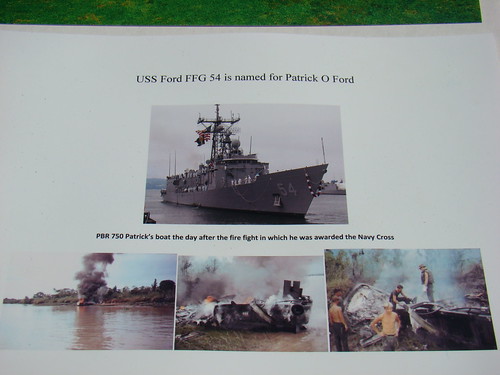
Here's the small crowd lined up, and boat ID. Built in Bellingham in 1973, it was one of the last training boats from when they roamed the SF Bay waters before being disestablished. Operations in new boats had to be restarted for Iraq service, now they are using big inflatable rigs.

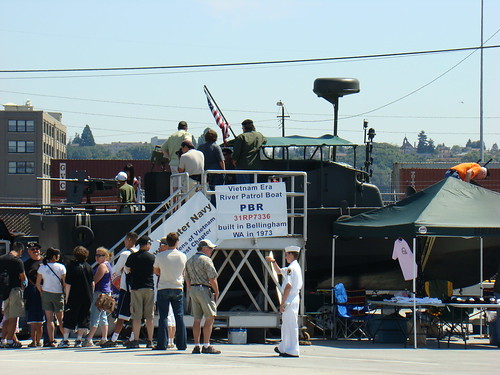
View just before getting onboard.

Rear 50 cal. These are the classic punch a hole in light armor half-inch shell machine guns
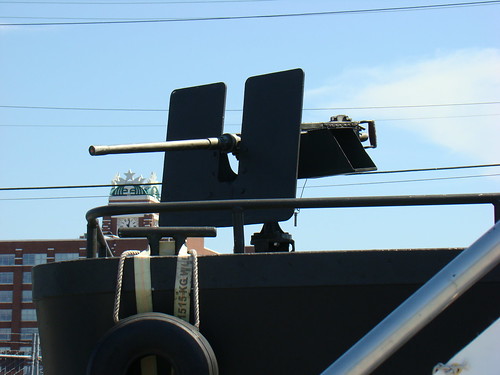
Side shields and placeholder for grenade launcher, 7.62 MG would be on other side.
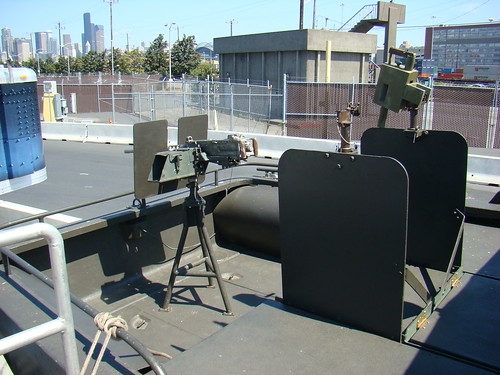
rear .50. Gun shield is all the armor you get.
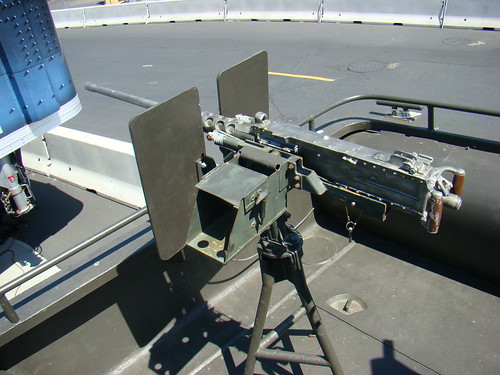
3 diesel engines under the floor.
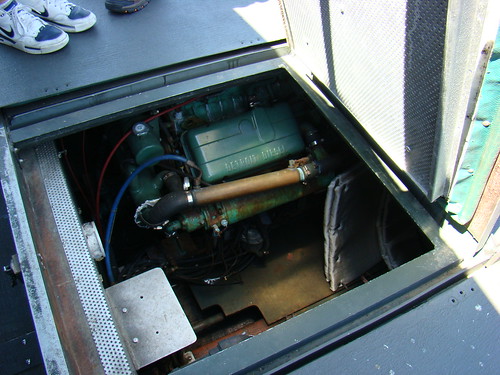
Hatch for jacuzzi water jets
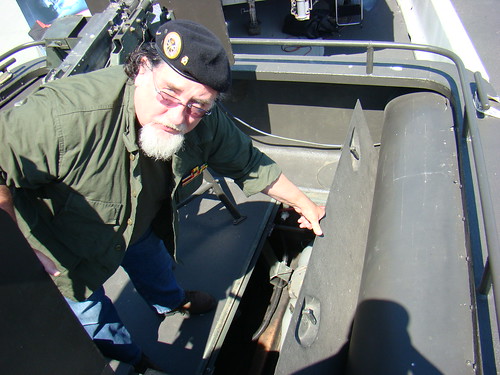
Water jet pump unit
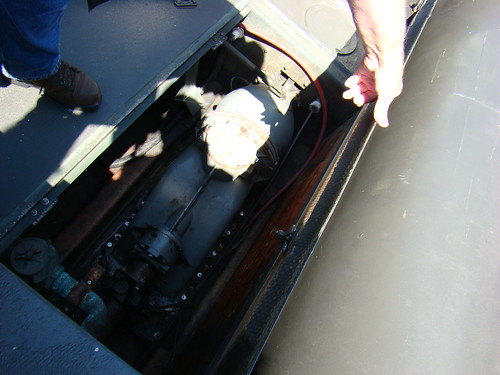
Bridge
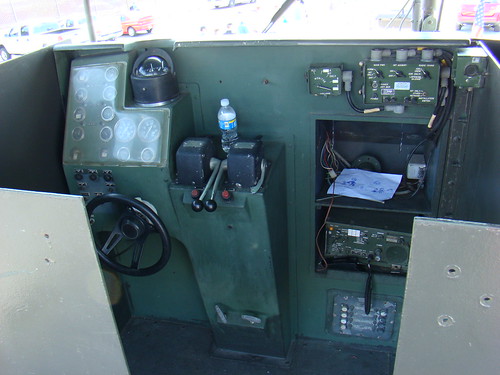
Talk with the Vet in back
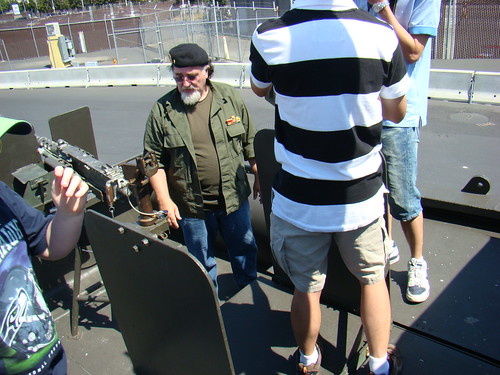
50 cal front gun turret / tub
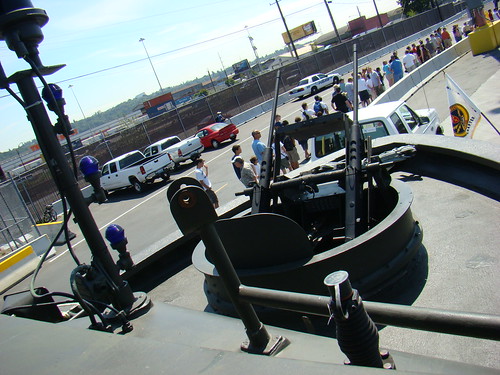
front twin 50 cal
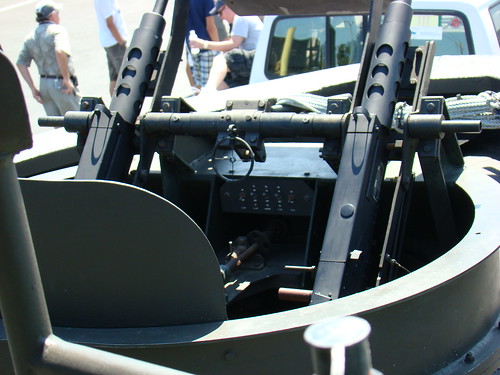
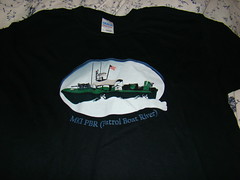
Cute T-shirt for tiny boat with 3 50s, 1 7.62 and 140mm grenade launcher
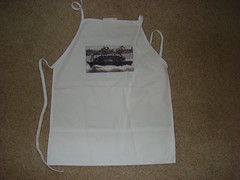 That's a manly apron
That's a manly apron
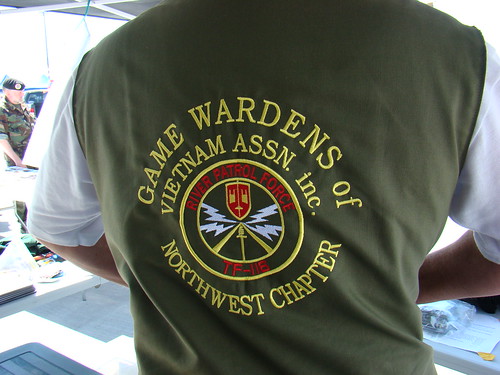
Subscribe to:
Posts (Atom)